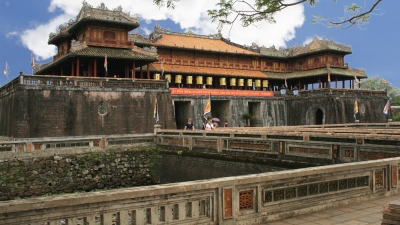 |
| Big Buddha: The biggest reclining Buddha statue in Viet Nam, which is 49m long and 7m tall, built in Ta Cu Mountain Tourism Area. |
by Trung Hieu
A lot of people may find the Ta Cu Mountain a strange place to be on, but in reality it makes for an attractive climb.
It is also one of the most interesting tourist attractions in the central province of Binh Thuan.
The 694m high mountain is located along National Highway 1A, in Ham Thuan Nam District, 28km to the south of Phan Thiet City (Binh Thuan's chief town).
On its slope of about 400m stands the Linh Son Truong Tho Pagoda (also known as Ta Cu Pagoda). Behind the pagoda is a giant, 49m long statue depicting the Buddha Shakyamuni attaining Nirvana.
The scenery here is truly enchanting with a long coastline, rocks of different shapes surrounded by green forests, that creates a majestic landscape.
Vu Minh Truong, a young traveller from Ha Noi, said that pilgrims usually choose to travel up the mountain by cable car, but his group of "professional backpackers" decided to climb up.
"In all probability, very few people have walked on this path so grass and plants have reached out to obscure the trail," he said.
Truong said that to reach the top of Ta Cu located inside the forbidden forest, they had to overcome 2,250m of slopes, passing the unsteady stone steps.
"After crossing more than 200m, we encountered a small clear stream crossing our path," he said.
The stream runs through boulders then flows down the slope of Ta Cu creating a wonderful image in the vast forests.
A young man in the group scooped up the water and exclaimed: "Too cool, guys!"
So they all washed the perspiration off their faces in the cool water.
"We walked cautiously above the slippery rocks to go ahead. Along the path, there were numerous roots crawling around. Here and there, some bamboo shoots reached out to prevent anyone from passing through, so we had to be careful to avoid getting hurt by the spikes," said Truong.
Tourists conquering the Ta Cu must carefully focus when their paths exceed 1,000m, because that is the highest ramp, said Chau Tuan, a local guide.
"All of us were sweating, our feet felt heavy, but we were ‘compensated' as we watched the towering ancient trees and heard the musical chirping of birds. It also seemed like we were able to breathe easier due to the cold fresh air created by the forests and the wind blowing around us," he said.
As travellers reached near the peak, the way was easy. Everyone admired the blue sky through the forest canopy and the valley below, just a distant shadow in the mist. The view was spectacular and almost poetic.
Passing hundreds of steps, the travellers finally reached the Ta Cu Pagoda.
"These are monuments and landscapes of architectural, artistic and cultural value," said Truong.
On the mountain peak is the statue of the reclining Buddha built in concrete, which is 49m long and 7m tall.
The statue was built under the guidance of local man Truong Dinh Y, from 1958 to 1962 by human labour without machinery or cranes, along with support from Buddhists throughout the southern provinces. It was the biggest reclining Buddha statue in Viet Nam at that time.
 |
| Easy ride: The cable car system takes around eight minutes to reach the top of Ta Cu Mountain. — VNS Photos Minh Quang |
Tran Minh Tue, a tourist from HCM City, said he had climbed up to the Ta Cu seven times with his friends.
"We began climbing the mountain in the evenings, so we could return the next morning. This may sound strange, but the schedule creates a different and romantic feeling for visitors. Climbing up at night would be very cool. If we climbed up in the day, we would feel tired because of the sun. It takes us about three hours to climb up, but only 90 minutes to come down.
"The beauty about Ta Cu is that the mountain stands alone, surrounded by gardens of dragon fruits and rice fields, beside the blue sea," he said.
On their way back in the afternoon, Truong's group decided to go down by cable car to watch Ta Cu from above.
"Sitting in the cabin above the green trees, the pleasant atmosphere made us feel refreshed," said Truong.
"Looking to the left, we saw the Ke Ga lighthouse that is more than 100 years old and still diligently guides boats to safety at night."
The landscape and relics on the mountain were recognised as a historical and culture site of national importance in 1993.
In 2002, Ta Cu Tourism Area was established at the foot of the mountain in an area of 24ha. Many projects to serve tourists have been constructed, particularly a modern Austrian cable car system that goes up to the mountain peak and was put into operation in September 2003.
The cable car consists of 25 cabins, with each carrying six persons and takes around eight minutes to reach the top.
In recent years, Ta Cu has become a venue for mountain climbing competitions that have attracted young people from nearby provinces.
"With the cool and fresh air, Ta Cu Mountain is an attractive destination for tourists and I believe many will return," Truong said. — VNS





















